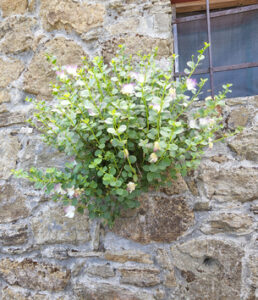
Capparis – more than just capers
By Clive Larkman
On a recent trip to the central Mediterranean I observed some tough growing conditions. Most of the plants were non-native but one that stood out was Capparis spinosa – the Caper Bush. It is a tough plant that is able to establish itself in poor conditions with minimal water and virtually no soil. We saw some plants that were growing out of crevices in stone walls. They, like most plants in the genus, have stunning flowers but otherwise the plant is nothing special, and would only be useful as a garden plant to fill a really, dry harsh spot.
However, as a food crop they are pretty special and before looking at their culinary uses (next month) we need to look at the botany of the genus. Caper is the common name for the processed buds of Capparis spinosa and all the plants in the genus, of which there are approximately 150 species (reduced from 250 after genetic review).
They are native to most parts of the globe but usually require what we call the classic ‘Mediterranean Climate.’ That is, mild cool moist winters and hot dry summers with little to no summer rain. There are some species that are vine like and come from traditional tropical climes. Many varieties are edible and some are important in local diets, and even have good commercial value. A few species are also poisonous, and as we would expect for a genus that has been cultivated for over 2000 years many varieties are in the pantheon of herbal medicines used around the world. There are also in excess of six hundred synonyms.
Capparis is a genus in the Family Capparaceae which includes around thirty other genera – none of which are of any great importance in the commercial or ornamental sectors. The family sits in the Order Brassicales, to which the Family Brassicaceae also belongs. There is some debate about combining Capparaceae and Brassicaceae into one Family. The interesting issue is the importance of brassicas in our diet. it means that plants in the Caper Family may also be of benefit to our health.
Caper species are an ‘old world’ plant, meaning there are no species from the Americas but they are widespread across Europe, Asia, Africa and Australasia. There are species for most climatic conditions but none can really tolerate extreme cold very well. This probably explains why there are few, if any, species native to countries with latitudes above 45 degrees (north or south). Climatic spread is from barren rocky outcrops in the Mediterranean, desert habitats in Africa and Asia, and tropical environments in Australia, Asia and the Pacific.
One variety, Capparis sandwichiana, is endemic to the Hawaiian Islands where it grows at lower elevations on the coast. The species name ‘sandwichiana’ doesn’t relate to making good sandwiches. It means “of the Sandwich Islands”, which was the original British name given to the Hawaiian Islands. The fruit was used as a medicinal plant by Indigenous Hawaiians.
There are nineteen described species native to Australia, mostly in the north east, but here are some that survive well in the dry parts of northern central Australia. Like the rest of the genus they range from low shrubs to climbers and even small trees. Some have long been part of the Indigenous people’s diet and are now becoming part of the ‘Bush Tucker’ range. They have edible fruits, a few of which possess medicinal properties, and others have potential in the rapidly growing caper industry.
One of the common names for the genus is ‘Flinders Rose’, for which there seems little historical reason. Most plants named after Flinders are of Australian origin, so the assumption is it was named after Matthew Flinders, or maybe for a variety named for the Flinders Ranges. The beautiful flower is certainly rose-like.
Before the Australian varieties can have a strong presence on the world stage, there needs to be some selection and targeted breeding. Like the popular Capparis spinosa, the Australian varieties are difficult when it comes to asexual propagation. They will grow okay from seed but the variation is too great for use as a farm plant. As well as the breeding, work needs to be done on grafting, cutting propagation or micro-propagation. It seems that Australia likes to produce great food plants but teases us by making them hard to commercialise. Next month we will look at Capparis spinosa and some modern developments in laboratory growth.
Main image: A tough plant that will pop out of wall crevices (Image: Clive Larkman)
